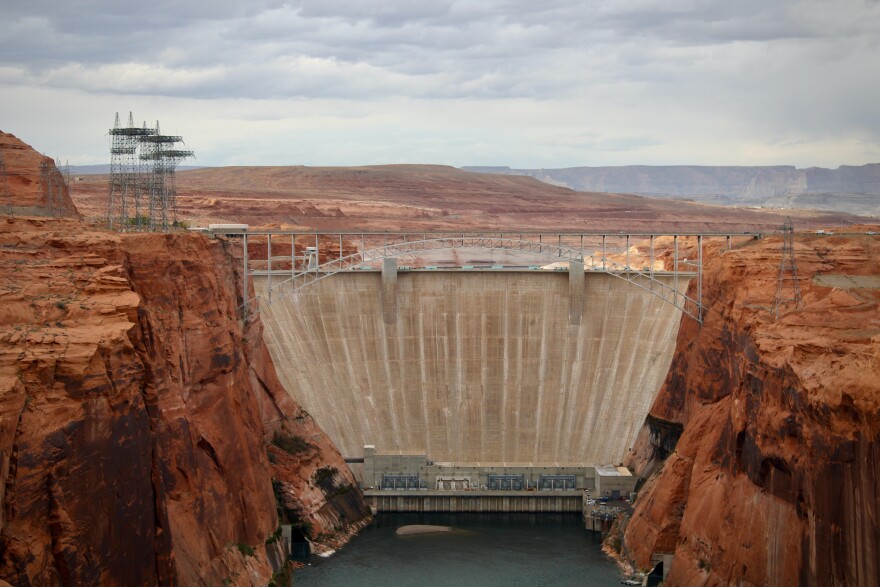The seven states that use water from the Colorado River have proposed competing plans for how the river should be managed in the future. They’re split into two factions, with the Upper Basin states of Colorado, New Mexico, Utah, and Wyoming on one side and their Lower Basin counterparts — California, Arizona, and Nevada —on the other.
Those two camps have often been at odds over water management over the past century. With climate change shrinking the Colorado River’s supply, they’re under intense pressure to rein in demand. The current guidelines for sharing the river expire in 2026, and states are trying to agree on the rules that will replace them.
Neither of the two competing plans submitted this week are final. Federal water officials and state leaders had been targeting a mid-March deadline for states to submit some kind of plan, with the aim of getting the ball rolling while there’s still enough time for the current administration to implement any new water rules. The upcoming election in November could bring a change of presidential administration that could complicate the implementation of new rules.
The Upper Basin states’ proposal puts one of their most oft-repeated talking points into writing: The four states in the Upper Basin bear the brunt of climate change — which is causing a reduction in the amount of snow in the mountains where the Colorado River begins — and any new rules for the river need to reflect that.
“We can no longer accept the status quo of Colorado River operations,” Becky Mitchell, Colorado’s top water negotiator, wrote in a press release. “If we want to protect the system and ensure certainty for the 40 million people who rely on this water source, then we need to address the existing imbalance between supply and demand. That means using the best available science to work within reality and the actual conditions of Lake Powell and Lake Mead. We must plan for the river we have - not the river we dream for.”
Mitchell and her Upper Basin colleagues are attempting to “plan for the river we have” by proposing a new structure for water releases from Lake Powell, the nation’s second-largest reservoir. In 2023, water levels in Lake Powell dipped to a new all-time low, about 20% of total capacity.
The Upper Basin states are suggesting releases as low as 6 million acre-feet of water per year. Currently, they are legally obligated to send at least 7.5 million acre-feet downstream each year, calculated as an average of the previous 10 years of flows from the river's Upper Basin to the Lower Basin.
But that new plan for reduced releases exists in murky legal territory.
The 1922 “Colorado River Compact,” which sets the table for today’s Colorado River management, says, “The States of the Upper Division will not cause the flow of the river… to be depleted” below a specified level.
The Upper Basin states now suggest allowing less water to pass downriver because climate change is causing the lower flows, not water use by the states themselves. The idea has not yet been tested in court.

Lower Basin leaders say that suggestion is impractical.
“Arguing legal interpretations until we’re all blue in the face doesn’t do anything to proactively respond to climate change,” JB Hamby, California’s top water negotiator, said.
Efforts to stop its levels from dropping further have been a core part of Colorado River management over the past few years. If water levels dip below the intake tubes for hydropower turbines within Glen Canyon Dam, operators would have to shut down electric generators that supply about 5 million people across seven states. At an even lower mark, referred to as “dead pool,” water could drop to levels too low to pass through the dam at all.
Those concerns drove a raft of emergency water releases from other upstream reservoirs and fueled environmental groups' calls to plan for a future without the Glen Canyon Dam.
The Upper Basin states’ proposal specifically mentions mitigating dead pool as an outcome of its suggested rules.
The Lower Basin states, meanwhile, tout their own plan. Their plan introduces a new framework for measuring how much water is in Western reservoirs and a method for distributing water cutbacks accordingly.
Currently, the main barometers for the amount of water in the Colorado River system are the elevations of Lake Powell and Lake Mead. The new accounting system, which the Lower Basin states describe as “more holistic,” would also include a handful of other reservoirs that are part of the Colorado River Storage Project. Those include Blue Mesa in Colorado, Navajo in New Mexico, and Flaming Gorge in Wyoming and Utah.
The Lower Basin states’ proposal suggests using data about how much water is in that bigger system to determine when it’s time to cut back on water allocations to different states and how big those cutbacks should be. Under current rules, only Lower Basin states have to face cutbacks during times of shortage. Under the proposed new rules, Lower Basin states would be the first to face cutbacks, but Upper Basin states would see water reductions, too, once reservoir storage dips below a certain threshold.
“It’s very easy to craft an alternative that doesn’t require any sacrifice,” Hamby said. “But that’s not what the Lower Basin alternative does. The Lower Basin is home to three-quarters of the Colorado River Basin’s population, most of the basin’s tribes, and some of the most productive farmland in the country. Our proposal requires adaptation and sacrifice by water users across the region.”
Some policy analysts have suggested that this week’s divergent proposals are an important step toward reaching a consensus and may be a necessary first step before negotiators are able to find some agreement.
“We need to think about the whole basin as one interconnected system,” Elizabeth Koebele, an assistant professor of political science at the University of Nevada, Reno, said. “I think there are elements of both plans that kind of get at that thought, and maybe those are places that we could see come together in a future consensus plan.”
Despite divides in the substance of their proposals, both the Upper Basin and Lower Basin states say they are open to more dialogue and have hopes of reaching an agreement.
“We look forward to working with our sister Lower Basin states to resolve differences in approach and create a seven-state consensus alternative,” Estevan López, New Mexico’s top water negotiator, wrote in a press release.
Officials with the Bureau of Reclamation, the federal agency that manages Western dams and reservoirs, said they expect to work with states over the spring and summer and reach a draft proposal for post-2026 river management by the end of 2024.
This story is part of ongoing coverage of the Colorado River, produced by KUNC in Colorado and supported by the Walton Family Foundation. KUNC is solely responsible for its editorial coverage.
Copyright 2024 KUNC.






